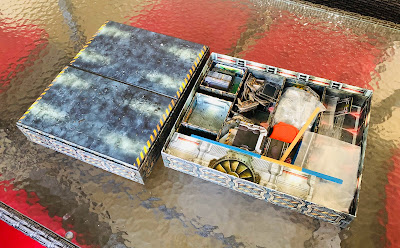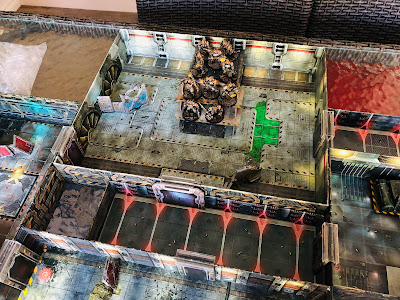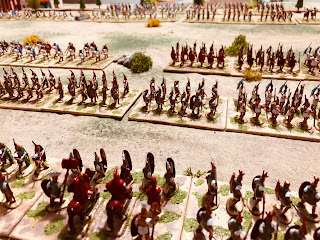This week I finally got my Samurai armies on to the tabletop for a couple of test games. The first games were testing out a slight variation to One Hour Wargames (OHW) Pike and Shot rules. The changes were to have an Ashigaru skirmisher unit of bows attacking with D6-2 and treat mounted Samurai as cavalry attacking D6+2. Foot Samurai were swordsman and Ashigaru units as pike and arquebus (musket). One of the reasons for picking these rules is the combined nature of weapon types in units of this period and particularly the combined pike and arquebus units. Not something many rulesets seem to cater for.
These provided a couple of enjoyable games which did include the use of chance cards. Having only six units per side I was able to increase the side of units to six bases each and larger units always look more visually appealing.
 |
| An early test game with OHW Pike and Musket rules adapted. |
It seems like a long while since I have had a gridded wargame on my tabletop. There should be more given the name of my blog. I did play a remote Samurai wargame, the Second Battle of Azukizaka, with Jon of Palouse Wargaming Journal earlier this year which used a hex grid. The gridded tabletop proving itself indispensable with remote gaming. The rules used were a version of Basic Impetus adapted by Jon to hexes.
So I decided to try a few square gridded games with the Samurai on 6 inch squares. Four bases each two by two inches fit quite nicely into the square and allow for terrain pieces to also fit. All being well I will be able to get another game played tomorrow.
 |
| A square grid is setup on the tabletop. |
 |
| A closer look at the grid squares and how units fit. |
As the painting side of the Samurai project is coming to a close, WW1 figures for the Palestine Campaign are starting to appear on the painting table.

















































